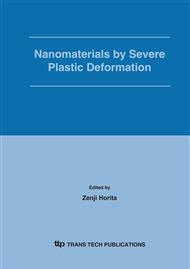p.379
p.385
p.391
p.399
p.407
p.413
p.419
p.425
p.433
Differences in Structural Evolution in Single- and Dual-Phase Materials during Severe Plastic Deformation
Abstract:
Severe plastic deformation (SPD) has been applied to two classes of metallic materials, single phase and dual phase materials. The applied shear strain has been varied between 1 and 1000 and the homologous temperature between 0.08 and 0.4. The deformation experiments are performed by high pressure torsion (HPT). The resulting microstructures were investigated by backscattered electron imaging, orientation image microscopy, and in selected cases by transmission electron microscopy. It will be shown that the behavior of single phase material is relatively uniform. With increasing strain, the size of the structural elements decreases and reaches a saturation between a shear strain of 10 to 100. The temperature and the alloying are the main parameters, which controls the saturation size of the structural elements (grains). The behavior in the dual phase materials is more complex, it varies from simple homogenisation, fragmentation of one phase, to desintegration and supersaturation of the phases.
Info:
Periodical:
Pages:
407-412
Citation:
Online since:
January 2006
Authors:
Price:
Сopyright:
© 2006 Trans Tech Publications Ltd. All Rights Reserved
Share:
Citation:


